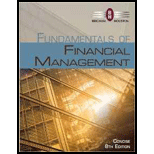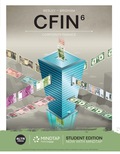
Concept explainers
To identify: The actions that stockholders can take to ensure that the management and stockholder’s interests are aligned.
Introduction:
Stockholders: Stockholders are the owner of the company who invest funds in the business. Stockholders have the voting right and control over the management. The relationship between the stockholder and manager is like the relationship of principal and agent
Managers: Managers are the agent of the stockholders who perform for the stockholders. The mangers should not do any such action which is detrimental to the interest of the stockholders. There can be a situation where conflicts may arise between manager’s personal interest and stockholders interest, in such situation the priority should be given to the stockholders interest.
Trending nowThis is a popular solution!

Chapter 1 Solutions
Bundle: Fundamentals of Financial Management, Concise Edition (with Thomson ONE - Business School Edition 6-Month Printed Access Card), 8th + Aplia Printed Access Card
- Kenji’s Tax Scenario Kenji is a young professional with taxable income of $138,000 as an advertising account executive. What is Kenji’s total tax liability? (Note: Round your answer to the nearest cent, if necessary.) What is Kenji’s top marginal tax rate? What is Kenji's average tax rate?arrow_forward1. A project manager is using the payback method to make the final decision on which project to undertake. The company has a 9% required rate of return and expects a 5% rate of inflation for the following five years. i. ii. What is the non-discounted payback of a project that has cash flows as shown in the table? What is the rate of return? (use equation given in class) Cash Outflow Cash inflow Net Flow Year 10 $500,000 0 1 12. * 0 $75,000 & $50,000 $150,000 3 $200,000 $350,000 4 0 $150,000 5 0 $750,000arrow_forwardProblem 4. Consider the following balance sheet for Watchover Savings Incorporated (in millions): Assets Liabilities and Equity Floating-rate mortgages (currently 12% per annum) Now deposits (currently 8% per $ 82 annum) $ 116 30-year fixed-rate loans (currently 9% per annum) 5-year time deposits (currently 8% per 101 annum) 29 Equity 38 $ 183 Total $ 183 Total a. What is Watchover's expected net interest income at year-end? b. What will be the net interest income at year-end if interest rates rise by 3 percent? c. Using the one-year cumulative repricing gap model, what is the change in the expected net interest income for a 3 percent increase in interest rates?arrow_forward
- You are given the following information for Frankenson Pizza Company: Sales = $72,000; Costs = $32,300; Addition to retained earnings = $6,500; Dividends paid = $2,220; Interest expense = $5,200; Tax rate = 23 percent. Calculate the depreciation expense. Note: Do not round intermediate calculations and round your answer to the nearest whole number, e.g., 32.arrow_forwardAssume coupons are paid annually. Here are the prices of three bonds with 10-year maturities. Assume face value is $100. Bond Coupon (%) Price (%) 2 4 8 81.62 98.39 133.42 a. What is the yield to maturity of each bond? b. What is the duration of each bond? Complete this question by entering your answers in the tabs below. Required A Required B What is the yield to maturity of each bond? Note: Do not round intermediate calculations. Enter your answers as a percent rounded to 2 decimal places. Bond Coupon (%) YTM 2 % 4 8 % % Required A Required R Required B What is the duration of each bond? Note: Do not round intermediate calculations. Round your answers to 2 decimal places. Bond Coupon (%) Duration 2 years 4 years 8 yearsarrow_forwardTwo building owners - Alice and Bob - each own a building worth $1,000,000. They are considering forming a mutual insurance pool. Based on historical data, there are three possible fire damage scenarios for each building in a given year: No damage: 85% probability Partial damage: 12% probability, with repair costs of $200,000 Total loss: 3% probability, with a cost of $1,000,000 Calculate the standard deviation of the loss of each owner with pooling (2 buildings together)arrow_forward
- Critically evaluate the usefulness of Net Present Value as an investment appraisal.arrow_forwardSales are $2.90 million, cost of goods sold is $590,000, depreciation expense is $148,000, other operating expenses are $298,000, addition to retained earnings is $1,126,625, dividends per share are $1, tax rate is 21 percent, and number of shares of common stock outstanding is 88,000. LaTonya's Flop Shops has no preferred stock outstanding. Use the above information to calculate the times interest earned ratio for LaTonya's Flop Shops, Incorporated. Note: Round your answer to 2 decimal places. Interest earned timesarrow_forwardTwo building owners - Alice and Bob - each own a building worth $1,000,000. They are considering forming a mutual insurance pool. Based on historical data, there are three possible fire damage scenarios for each building in a given year: No damage: 85% probability Partial damage: 12% probability, with repair costs of $200,000 Total loss: 3% probability, with a cost of $1,000,000 Calculate the standard deviationarrow_forward
- What is the role of the researcher, population and sampling, and data collection, could you help explain each one of them? How to start working on the population structures essential to research? What are the structured ways in which to present key research elements?arrow_forwardCould you please help explain the Qualitative Research Data Analysis? What is the Coding, and Interrater Reliability? How do they work and when we use them?What are the description of populations and Samples, please help to explain them.arrow_forwardDon't used hand raiting and don't used Ai solutionarrow_forward

 Intermediate Financial Management (MindTap Course...FinanceISBN:9781337395083Author:Eugene F. Brigham, Phillip R. DavesPublisher:Cengage Learning
Intermediate Financial Management (MindTap Course...FinanceISBN:9781337395083Author:Eugene F. Brigham, Phillip R. DavesPublisher:Cengage Learning Intermediate Accounting: Reporting And AnalysisAccountingISBN:9781337788281Author:James M. Wahlen, Jefferson P. Jones, Donald PagachPublisher:Cengage Learning
Intermediate Accounting: Reporting And AnalysisAccountingISBN:9781337788281Author:James M. Wahlen, Jefferson P. Jones, Donald PagachPublisher:Cengage Learning EBK CONTEMPORARY FINANCIAL MANAGEMENTFinanceISBN:9781337514835Author:MOYERPublisher:CENGAGE LEARNING - CONSIGNMENTBusiness/Professional Ethics Directors/Executives...AccountingISBN:9781337485913Author:BROOKSPublisher:Cengage
EBK CONTEMPORARY FINANCIAL MANAGEMENTFinanceISBN:9781337514835Author:MOYERPublisher:CENGAGE LEARNING - CONSIGNMENTBusiness/Professional Ethics Directors/Executives...AccountingISBN:9781337485913Author:BROOKSPublisher:Cengage





